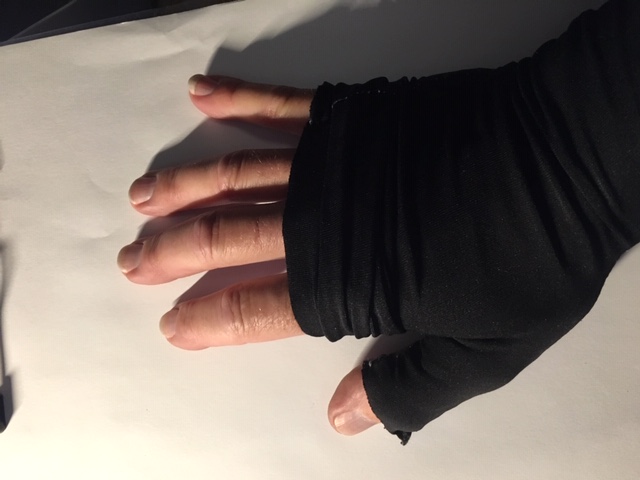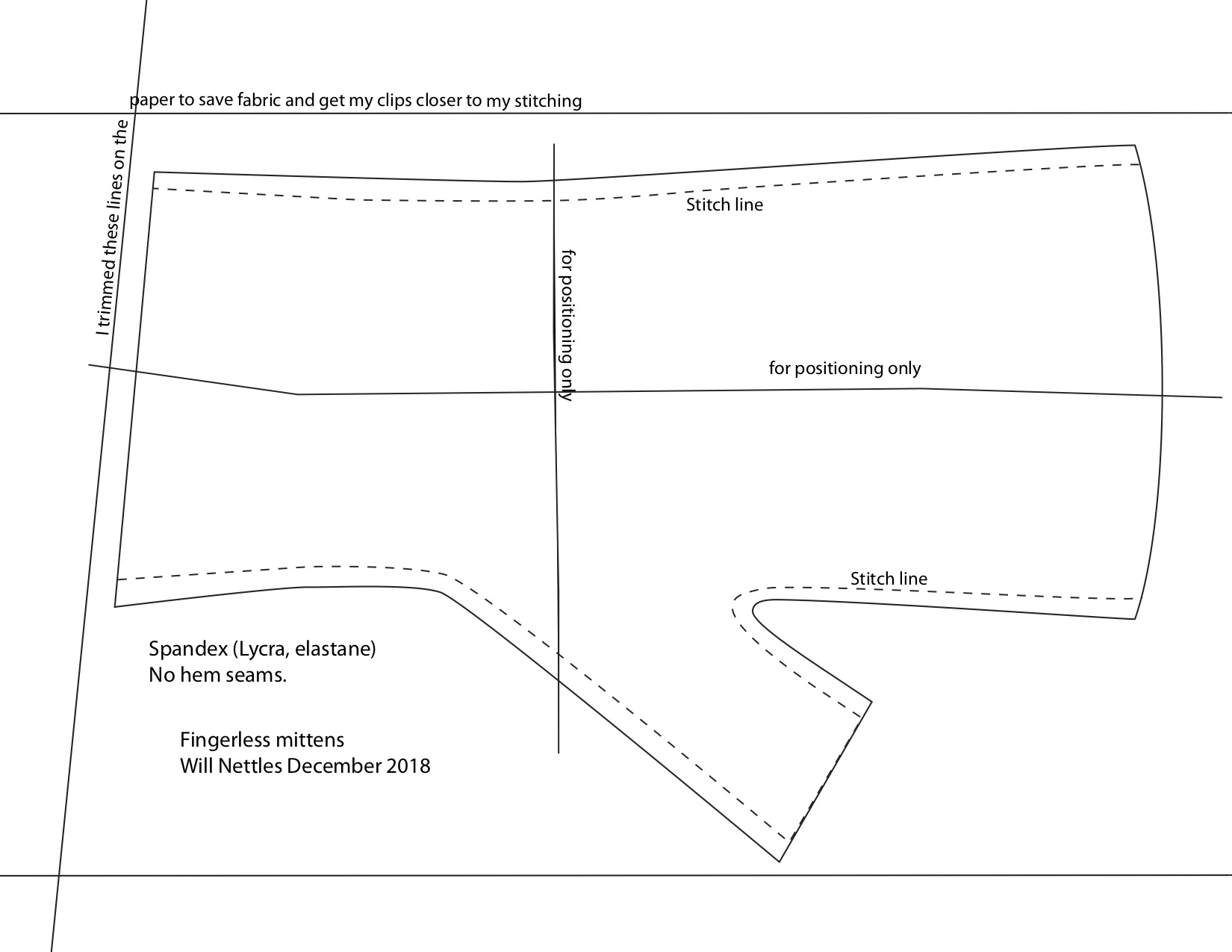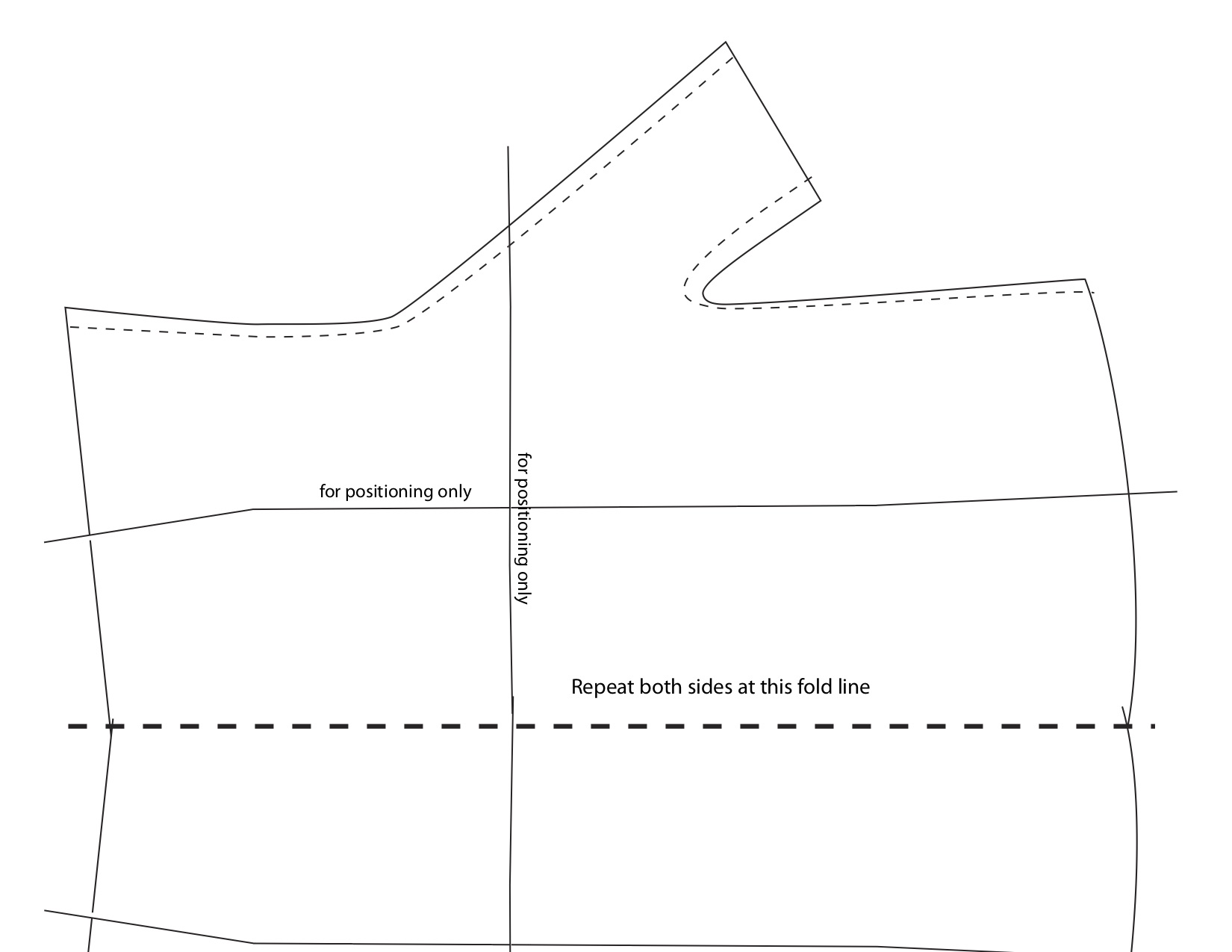Topic
MYOG Fingerless Mittens easy
Forum Posting
A Membership is required to post in the forums. Login or become a member to post in the member forums!
Home › Forums › Gear Forums › Make Your Own Gear › MYOG Fingerless Mittens easy
- This topic has 15 replies, 6 voices, and was last updated 5 years, 1 month ago by
 Jerry Adams.
Jerry Adams.
-
AuthorPosts
-
Dec 12, 2018 at 7:59 pm #3568695
I needed something to keep my hands warm for typing and handwriting in the winter months.
This started as a discussion in the regular gear area, I thought it should be over here.
https://backpackinglight.com/forums/topic/best-fingerless-gloves/#post-3568692
Dec 12, 2018 at 8:31 pm #3568702I found most fingerless gloves and thin gloves to just get in the way. The serging (stitches) at the finger cutoffs is always annoying.
When I googled the topic I found all these fashionable things that are more like ‘fingerless mittens.’ So I thought I’d make some using spandex (aka Lycra, elastane), the stretchiness would overcome my sewing shortcomings, and being synthetic the material insulates. (The spandex I have is 4 way stretch but I don’t think there’s a weight rating. The wind blows through it. Capoline or smart wool might be a good option. )
The basic theory of fingerless gloves or mittens is: to keep your hands/fingers warm: cover as much of your fingers as possible, but allow for as much freedom of motion as needed for the task. Operating a smart phone is one finger, typing is all ten, handwriting is dexterity in just one hand, and the fingers don’t need to be uncovered.
I thought I’d try making the fingerless mittens. I found cutting the spandex difficult, scissors or rotary cutter. So I folded over the spandex on a clipboard, clipped it to one edge at the ends, then clipped on the pattern. Next I carefully worked one end off the clipboard and then the other. Then I clipped around the edge of the paper pattern. Then I just followed the dotted sew line. Could not have been easier.
Then I cut out the pattern, and finally I picked off as much of the paper as I could (it’s pretty tenacious where you reverse your stitching to lock it in.). The stitching does a lot of work cutting out the form. The bits of paper that remain don’t get in the way, will fall out over time, or just wash ’em. (I used a short zigzag stitch, but I don’t think it matters, and for thread….cotton that was already in my machine and Gutterman for the bobbin, only because it was the only loaded bobbin on hand. )
I do not edge stitch or hem the open wrist or finger ends–it’s just not needed. And if you make these ends longer, you’ll easily see how much to trim later–so make your reverse locking stitches longer. A nice long drape over the fingers helps keep them warmer. Took less than ten minutes. It’s idiot proof.
The second pattern is so the heel side of the hand doesn’t need sewing, just align the fold with the fold on your fabric.
My hands are average sized, about 8.5 inches around the palm, so scale up or down as needed. I found a slightly lager pair to be just a bit better for typing because you need to spread your fingers more.
The way I use them is I just pull back the ‘sleeve’ to free up only as much of my fingers as I need. This is the whole trick of this design. You can also pop out your thumb and then roll them up over your wrists. (hand buffs?) They might work as liners in mittens… or over the wrists until they are needed…
In the photo holding the pen, you can see I’ve got my thumb covered, it works for me, and for this pen, it might not work for other pens, people. I can easily adjust to expose more or less thumb or fingers. Some thinned silicone sealant could be smeared on for grip…. And while writing my left hand isn’t used, so I let the sleeve drape over the ends of my fingers.
I’ve tried different fingerless gloves, these are more comfortable and a lot more versatile. Outdoors in the wind, they’re too porous. Other materials would probably be better. If you need to type, then stretchiness is critical, for other tasks not as much, but I think you’ll need some.
(The patterns below: 9.154″ the long positioning line top to bottom, or whole sheet is 8.5 x 11″ I couldn’t upload a pdf so I’m not sure if they’ll open on other computers the correct size.)
Back on the Gear thread of this others have commented on their experiences with fingerless gloves and Ryan “Rudy” Oury posted a pair he made from a smart wool sock.
Hope this is of some use to others.



 Dec 12, 2018 at 8:33 pm #3568703
Dec 12, 2018 at 8:33 pm #3568703I do that with fleece. A little warmer than spandex.
I just sew the seams with one row of stitches. Maybe a second row just to make sure it doesn’t come undone. Then cut off the fabric close to the seam. Fleece doesn’t unravel so you don’t need to do a french seam or anything.
There’s not a lot of reason to make them fingerless gloves. For full gloves/mittens, making them gloves allows you to use your hands (fingers) better, but it’s awkward with a layer of material over them. Fingerless mittens are easier to make. Since they’re fingerless, you get full use of your fingers without making them gloves.
Fingerless gloves or mittens allow me to operate stove, cook, eat,… The mittens covers maybe 2/3 the surface area of hand/finger/wrist so provides a lot of warmth. When I’m not doing stuff with my fingers I just put them in my pockets. No reason to have full gloves/mittens.
Dec 12, 2018 at 8:37 pm #3568704Since they’re gloves, it’s pretty simple, no need for pattern or anything
Sew something approximately correct. Try them on. Sew another row of stitches closer as needed. When satisfied sew another row of stitches then cut off excess fabric.
It’s difficult to sew a row of stitches too close to edge of fleece, so cut off excess only when you’re done
Dec 12, 2018 at 8:43 pm #3568705They’d be warmer with synthetic insulation, like 2.5 oz/yd2 Apex. Fold over the liner fabric over the top edge to make it a clean edge. Sew a row of stitches inside just a bit to keep Apex from shifting. Then proceed the same as fleece. I’d just leave a raw edge of liner/Apex/liner, or maybe make it a French seam.
But then it wouldn’t be stretchy, maybe no big deal.
With fleece, it’s stretchier in one direction, make sure that goes around your hand, not up and down.
Dec 12, 2018 at 9:05 pm #3568711Thanks Jerry, these are great tips. I’ve got an old fleece zip-up with a busted zipper that I might try. The thinner Climashield Apex is interesting too.
As thicker materials become an option, there might be a benefit to using the heavier material on the top of the hand… My whole goal with this is the versatility that the long drape over the fingers gives me.
Dec 13, 2018 at 2:36 am #3568749Okay, I made one out of fleece. The wrist and the thumb are a bit tighter–too tight. The thickness of the fleece is roughly 3/32 ( 2- 2.5mm.) It’s too thick.
It is flexible enough for finger spreading, but the bulk renders it not as versatile as the spandex. I’m typing with fleece on one hand spandex on the other, the fleece needs to be pushed up more-exposing my fingers. Typing is okay, slightly more cumbersome. However, it doesn’t work at all holding a pen: Pushing up the material to clear my fingers creates a lump in my palm, this makes holding a pen too awkward. I’m sure it’s warmer though.
So what’s in between? Capoline? Merino wool? How well do they block the wind? As this advances I think the materials will become very task specific. What I need for writing and typing out of the wind, will be very different from what someone else will need for operating a camera, or other tasks in the wind.
What are the thinnest, best wind blocking and insulating materials?
On the gear discussion someone mentioned some Montbell fingerless options, including a ‘palm warmer’ that is a fingerless mitten, but with no length. It’s the drape over the fingers and the adjustable length that is the best feature of this design.
Dec 13, 2018 at 3:53 am #3568756We call those Wristlets and they are a good way to cheaply and easily keep fingers warm. I wear mine over my liner gloves when it is really cold for that little bit extra warmth inside my mittens or my shell mittens. But I use old socks too as a field expedient solution.
Dec 13, 2018 at 1:04 pm #3568789Dec 13, 2018 at 3:29 pm #3568802That’s just what I do
That is about the easiest MYOG project but there’s a risk of addiction : )
I like how quickly William was able to make one
Maybe just cut off the end a bit, so it doesn’t cover your fingers, like what Ken posted
Dec 13, 2018 at 5:18 pm #3568819Gosh, thanks Jerry. The whole idea of this design is that they extend beyond your fingers and you just bunch them up to expose as much of your fingers and thumb as is needed for the task at hand. Right now in my slightly chilly house (66 °F, 17C) I’ve got them bunched up to my knuckles.
The drape or extension past the fingers should be as much as is needed to keep your fingers warm, but not so much that bunching it up to use your fingers causes a problem (as the fleece one makes using a pen too difficult. There might be another option here if slits are cut so a pen can be held without any bunching.) I’d suggest making a pair long enough to let them go an inch or two beyond your fingers, bunch ’em up as needed, and later trim off any excess.
Terminology: We say ‘roll up your sleeves,’ which can mean we literally roll them up, but we don’t usually say, ‘bunch up your sleeves’ when we just push them up. So ‘bunch up’ is essential to this design, as is ‘drape’.
To totally go off the deep end. The rapid development of the American axe in the years after the Pilgrims arrived in Massachusetts set-up a general concept of ‘everything can be made better, ain’t nothin’ perfect or will ever be.’ So anything and everything can be improved, tweaked– endlessly. Something like these fingerless mittens are so simple it was easy to just get started. Other gear takes more thought and effort. Some of the small companies making DCF gear are doing some terrific things that are long over due. What always blows my mind when I start googling is how much stuff is exactly the same everywhere. There must generally be a huge disconnect between making and selling the stuff, and actually using it.
Dec 13, 2018 at 5:54 pm #3568826” I’d suggest making a pair long enough to let them go an inch or two beyond your fingers, bunch ’em up as needed, and later trim off any excess.”
Yeah, good idea, they’re so easy to make and the material is cheap.
I didn’t mean to be critical of you or anything. Everyone is different. Different uses. Interesting to get your experiences with different lengths and materials.
“So anything and everything can be improved, tweaked– endlessly”
Uh oh, that’s me, I can’t stop tweaking things : )
Dec 13, 2018 at 11:31 pm #3568853William,
Thanks for starting this thread. I’m going to make (or have my wife make) fingerless mittens for sun protection as I can’t bring myself to buy the OR sun gloves shown below.
 Feb 20, 2019 at 4:38 am #3579478
Feb 20, 2019 at 4:38 am #3579478Thanks for posting this. Very cool. I made similar wrist warmers out of an old pair of socks by trimming and sewing as necessary to get the preferred shape. The elastic in the socks was still good enough to hold them snug on my wrist. They are very versatile. Love them.
-Michael
Feb 28, 2019 at 3:02 pm #3580972Sun protection is cool. Socks? That’s probably where I should’ve started. It’s more logical.
I was fussing with my smart wool zip-up. It has thumb loops at the end of the sleeves. When I tried putting my fore finger through the hole my thumb was all jammed up in the sleeve. This seems to indicate that the options for covering up the fingers, hand… has to always address the thumb issue. After that the options are wide open.
Why do I have cold fingers? I don’t know. I do know that for my entire life I’ve had cold fingers and toes.
Over the past ten years (I’m 63) my feet got bigger. Most of my life I wore size 8-1/2 (US) shoes. Now they measure to 9+, effectively 9-1/2 , I’ve got some pairs of 10-1/2. A month ago my toes were red, numb (and of course I bumped them-painfully- about 6 times. ) My condition is probably just <b>Chilblains </b>but it might be <b>Reynaud’s Syndrome</b> (I’ve had some pale patches on the bottom of my feet). The basic treatment is movement and warmth.
The problem caused by growing feet and old tight shoes is of course jammed toes and poor circulation. (I thought I had wide feet. Sure, but the larger proper shoe size is wider. What helps when my toes go numb is to get on the treadmill. I suspect that once circulation has chilled too much: movement is as important as warmth. Movement to improve circulation seems to be far more effective for toes than fingers– but of course that may just be me. Now I figure that I just have to keep my feet covered when it’s chilly. Yesterday I went out on the ocean. I wore Sealskinz socks (the long ones) and NRS rubber water shoes. I’ve also added a full foot panel (tied into my Yakima pegs. Foot pegs are an abomination. If you paddle correctly, you’ll cut the circulation off to your toes, and a peg will break off every other year). My feet stayed warm for two hours no problem. (Sealskinz are great: just never ever get water inside. If that happens you’ll think they aren’t waterproof, and they’re colder than bare skin)
Feb 28, 2019 at 3:12 pm #3580974Interesting, I’m 65 and I think maybe my feet have gone from 12 to 13. I’ve heard that story before.
On my list of things to do is make some fingerless mittens that are longer and made with lighter material. I have some good fabric I almost threw away, but then I said “I could make some fingerless mittens with this”…
-
AuthorPosts
- You must be logged in to reply to this topic.
Forum Posting
A Membership is required to post in the forums. Login or become a member to post in the member forums!
Our Community Posts are Moderated
Backpacking Light community posts are moderated and here to foster helpful and positive discussions about lightweight backpacking. Please be mindful of our values and boundaries and review our Community Guidelines prior to posting.
Get the Newsletter
Gear Research & Discovery Tools
- Browse our curated Gear Shop
- See the latest Gear Deals and Sales
- Our Recommendations
- Search for Gear on Sale with the Gear Finder
- Used Gear Swap
- Member Gear Reviews and BPL Gear Review Articles
- Browse by Gear Type or Brand.







